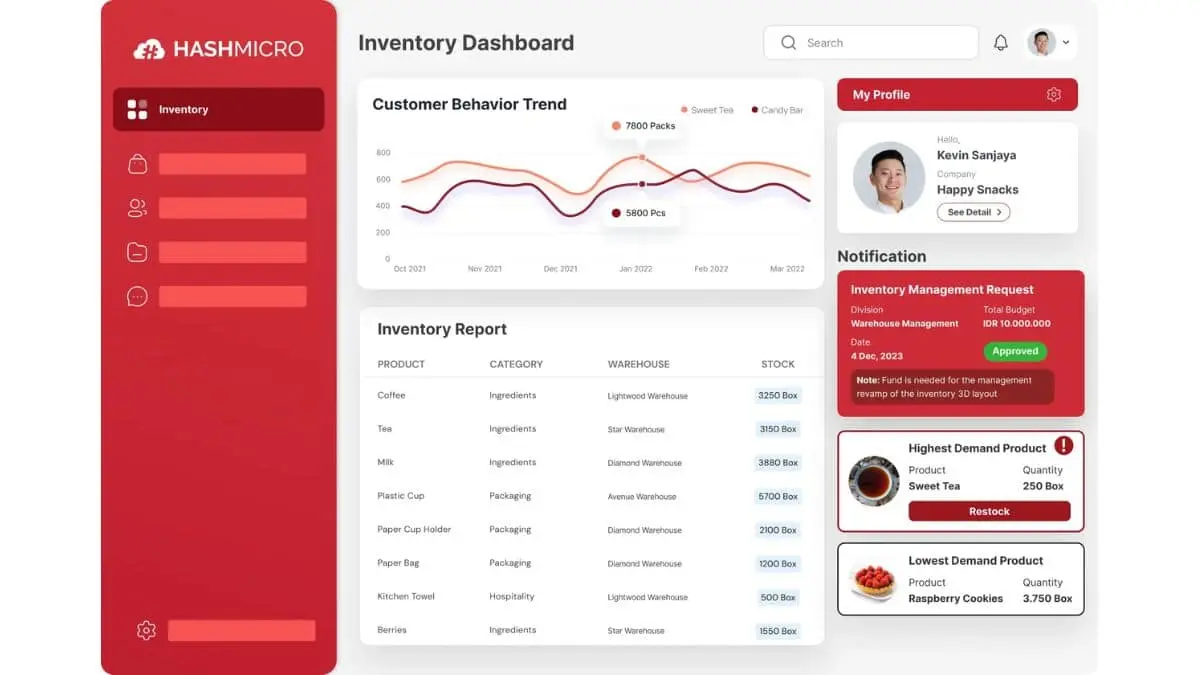Managing inventory can be a game-changer; getting a handle on your inventory can make all the difference. Mess it up, and you might lose sales or end up with piles of unsold stock. But don’t worry—we’re here to share ten inventory management techniques that can streamline operations, reduce costs, and increase profits.
Now, we know that managing inventory in the Philippines comes with its own set of challenges, like unpredictable demand and supply chain hiccups. But with the right approach, you can tackle these issues head-on, stay competitive, and keep your customers returning. In the next sections, we’ll walk you through some practical strategies that can make a difference in managing your inventory and growing your business.
Key Takeaways
|
Table of Contents

What is Inventory Management?
Inventory management involves overseeing the ordering, storage, and use of materials or products that a business sells. It ensures the right stock quantity is available at the right time to meet customer demand. This process avoids unnecessary costs by balancing sufficient stock levels and minimizing excess inventory. Effective management prevents capital from being tied up and reduces holding costs.
For businesses in the Philippines, inventory management is essential to daily operations. Understanding inventory management is crucial when managing a sari-sari store, a distribution center, or a manufacturing plant. Optimizing inventory levels reduces costs, improves cash flow, and enhances customer satisfaction. This leads to a more successful and efficient business.
Why is Inventory Management Important?
Effective inventory management is vital for business success, especially in the volatile Philippine market. Proper management ensures you always have the right products in stock, reducing the risk of lost sales. It also prevents overstocking, which can increase storage costs and lead to waste if products expire or become obsolete. This balance is key to maintaining profitability.
Maintaining optimal inventory levels not only saves costs but also boosts customer satisfaction and loyalty. When customers trust that you’ll have the products they need, they’re more likely to return and recommend your business. Efficient inventory management also frees up capital for reinvestment in marketing, product development, or expansion. This strategy strengthens your overall business performance.
Essential Inventory Management Techniques
- FIFO (First-In, First-Out) vs. LIFO (Last-In, First-Out): For Philippine businesses dealing with perishable goods like food or pharmaceuticals, FIFO is crucial to sell products before they spoil. On the other hand, LIFO benefits industries facing rising prices, aligning costs with current revenues. This strategy is vital in listing inventory.
- Demand Forecasting: Accurate demand forecasting is crucial for businesses in the Philippines, where seasonal trends and economic shifts impact demand. Predicting customer needs helps maintain optimal stock levels, avoiding costly overstocking and stockouts. This approach ensures businesses stay competitive in a dynamic market.
- ABC Analysis: For Filipino businesses, ABC analysis helps prioritize resources by focusing on high-value items that drive the most revenue. By categorizing inventory, businesses can allocate more attention and resources to ‘A’ items, ensuring these crucial products are always available to meet customer demand.
- Just-in-Time (JIT) Inventory: JIT is particularly advantageous for Philippine businesses with limited storage space and high storage costs. By ordering inventory only when needed, businesses can reduce holding costs and minimize the risk of obsolescence, which is vital in a market with fast-moving consumer goods.
- Safety Stock Inventory: Given the potential for supply chain disruptions in the Philippines, maintaining safety stock is crucial. It acts as a buffer, ensuring that businesses can meet customer demand even when unexpected fluctuations occur, such as delays due to weather or transportation issues.
- Economic Order Quantity (EOQ): EOQ helps Philippine businesses minimize total inventory costs by determining the most cost-effective order quantity. This is especially beneficial in a market where managing costs is key to maintaining competitiveness and profitability.
- Reorder Points: Setting accurate reorder points is vital for businesses in the Philippines to avoid stockouts, particularly in a market where lead times can be unpredictable. By establishing the right reorder points, businesses ensure timely restocking, helping maintain smooth operations.
- Cross-Docking: For businesses in the Philippines, cross-docking minimizes storage time and costs by transferring goods directly from incoming to outgoing shipments. This technique is particularly useful for fast-moving products, speeding up delivery and reducing warehouse space needs. It enhances efficiency in the supply chain.
- Minimum Order Quantity (MOQ): Understanding and negotiating MOQs is crucial for balancing inventory costs in the Philippines. While a lower MOQ can help reduce holding costs, businesses must also consider potential increases in per-unit costs, making it essential to find the right balance for their operations.
- Perpetual Inventory Management: Perpetual inventory management provides Filipino businesses with real-time inventory tracking, ensuring accuracy in stock levels and reducing the risk of discrepancies. This approach supports better decision-making and helps maintain efficiency in a dynamic market.
Implementing another inventory software also can improve the overall inventory management techniques.
Best Practices for Implementing Inventory Management Techniques
1. Utilize Inventory Management Software
Incorporating inventory management software into your business operations can significantly enhance your ability to track, manage, and optimize inventory levels. These tools offer automation, real-time tracking, and analytics that can streamline your processes and reduce the risk of errors. For Philippine businesses, using inventory management software can also help you comply with local regulations and improve overall efficiency.
2. Regular Inventory Cycle Counts
Regular inventory cycle counts are essential for maintaining accurate inventory records and identifying discrepancies early. Unlike a full physical inventory count, cycle counting involves checking a portion of inventory regularly, which allows for continuous monitoring without disrupting operations.
3. Appoint a Dedicated Inventory Manager
Having a dedicated inventory manager can make a significant difference in how effectively your business manages inventory. An inventory manager oversees processes, implements best practices, and ensures optimized inventory levels to meet demand without overstocking.
Incorporating an inventory management tools, conducting regular cycle counts, and appointing a dedicated inventory manager are key strategies to enhance inventory accuracy, optimize levels, and streamline operations for Philippine businesses.
How to Choose the Right Inventory Management Technique for Your Business
Selecting the right inventory management technique depends on various factors, including your business size, industry, and specific needs. For example, a small retail store in the Philippines might use simple techniques like FIFO and regular cycle counts. In contrast, a large manufacturing company may require advanced methods such as EOQ and JIT.
It’s also important to consider the unique challenges and opportunities in the Philippine market when choosing inventory management techniques. Factors such as supply chain reliability, customer preferences, and economic conditions can influence which techniques are most effective.
By tailoring your inventory control system to your business’s specific needs, you can optimize inventory levels, reduce costs, and improve customer satisfaction.
HashMicro’s Software for Easy Techniques Application
Implementing effective inventory management techniques can be challenging, but with the right tools, it becomes much easier. HashMicro’s inventory management software is designed to simplify these techniques, providing Philippine businesses with a comprehensive solution that automates and optimizes their inventory processes.
By leveraging advanced technology, HashMicro ensures that businesses can stay ahead of the competition and meet customer demands with ease.
Key Benefits of HashMicro’s Inventory Management Software:
- Automated Inventory Tracking: Keeps real-time records of stock levels, supporting methods like FIFO, LIFO, and perpetual inventory system management.
- Demand Forecasting and EOQ Calculation: Optimizes inventory levels by predicting demand and determining the most cost-effective order quantities.
- ABC Analysis and JIT Support: Automates inventory categorization and integrates JIT practices, minimizing waste and holding costs.
- Reorder Point and Safety Stock Alerts: Automatically sets reorder points and provides alerts for maintaining critical safety stock levels.
- Cross-Docking and MOQ Management: Streamlines cross-docking processes and helps manage minimum order quantities to balance costs.
HashMicro’s software provides an all-in-one solution, automating the application of these essential inventory management techniques. No matter how many different software options there are, HashMicro stands out as the one that seamlessly connects all these techniques into a unified system. For businesses in the Philippines, this means more efficient operations, reduced costs, and greater focus on growth and customer satisfaction.
Conclusion
Effective inventory management is crucial for success in the competitive Philippine market. By incorporating techniques such as demand forecasting, regular cycle counts, and appointing a dedicated manager, you can not only optimize inventory but also reduce costs and enhance customer satisfaction.
Furthermore, HashMicro’s inventory management software seamlessly simplifies these processes, offering an all-in-one solution tailored to your specific business needs.
Therefore, don’t wait to improve your inventory practices. Start by assessing your current processes, identifying areas for improvement, and exploring how HashMicro can help you achieve better inventory control. Additionally, sign up for a free demo today to discover how our software can transform your business.

Frequently Asked Questions
-
What are the three major inventory control techniques?
The three major inventory control techniques are FIFO (First-In, First-Out), LIFO (Last-In, First-Out), and JIT (Just-in-Time). Each method helps manage inventory flow and minimize costs.
-
What is the technique of effective inventory management?
Effective inventory management involves demand forecasting, ABC analysis, and maintaining safety stock. These techniques ensure accurate stock levels and smooth operations.
-
What is the most effective method for controlling inventory?
The most effective method is using an automated inventory management system, which allows real-time tracking and optimized stock management.





















